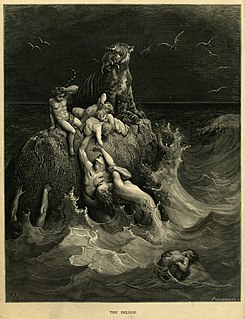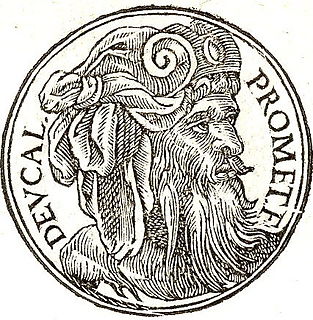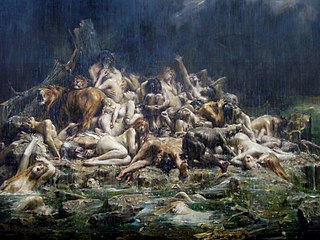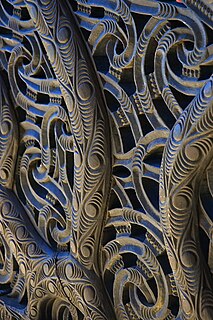 W
WA flood myth or deluge myth is a myth in which a great flood, usually sent by a deity or deities, destroys civilization, often in an act of divine retribution. Parallels are often drawn between the flood waters of these myths and the primaeval waters which appear in certain creation myths, as the flood waters are described as a measure for the cleansing of humanity, in preparation for rebirth. Most flood myths also contain a culture hero, who "represents the human craving for life".
 W
WThe antediluvian period is the time period chronicled in the Bible between the fall of humans and the Genesis flood narrative in the biblical cosmology. The term was coined by Thomas Browne. The narrative takes up chapters 1–6 of the Book of Genesis. The term found its way into early geology and science until the late Victorian era. Colloquially, the term is used to refer to any ancient and murky period.
 W
WAtra-Hasis is an Akkadian epic, recorded in various versions on clay tablets, named for its protagonist, Atrahasis. The Atra-Hasis tablets include both a creation myth and one of three surviving Babylonian flood myths. The name "Atra-Hasis" also appears, as king of Shuruppak in the times before a flood, on one of the Sumerian King Lists.
 W
WBochica is a figure in the religion of the Muisca, who inhabited the Altiplano Cundiboyacense during the arrival of the Spanish conquistadors in the central Andean highlands of present-day Colombia. He was the founding hero of their civilization, who according to legend brought morals and laws to the people and taught them agriculture and other crafts.
 W
WThe Book of Enoch is an ancient Hebrew apocalyptic religious text, ascribed by tradition to Enoch, the great-grandfather of Noah. Enoch contains unique material on the origins of demons and giants, why some angels fell from heaven, an explanation of why the Genesis flood was morally necessary, and prophetic exposition of the thousand-year reign of the Messiah.
 W
WCantre'r Gwaelod, also known as Cantref Gwaelod or Cantref y Gwaelod, is a legendary ancient sunken kingdom said to have occupied a tract of fertile land lying between Ramsey Island and Bardsey Island in what is now Cardigan Bay to the west of Wales. It has been described as a "Welsh Atlantis" and has featured in folklore, literature, and song.
 W
WThe Classic of Mountains and Seas, also known as Shan Hai Jing, formerly romanized as the Shan-hai Ching, is a Chinese classic text and a compilation of mythic geography and beasts. Versions of the text may have existed since as early as the 4th century BC, but the present form was not reached until the early Han dynasty a few centuries later. It is largely a fabulous geographical and cultural account of pre-Qin China as well as a collection of Chinese mythology. The book is divided into eighteen sections; it describes over 550 mountains and 300 channels.
 W
WIn Greek mythology, Deucalion was the son of Prometheus; ancient sources name his mother as Clymene, Hesione, or Pronoia. He is closely connected with the flood myth in Greek mythology.
 W
WThe Epic of Gilgamesh is an epic poem from ancient Mesopotamia, regarded as the earliest surviving great work of literature and the second oldest religious text, after the Pyramid Texts. The literary history of Gilgamesh begins with five Sumerian poems about Bilgamesh, king of Uruk, dating from the Third Dynasty of Ur. These independent stories were later used as source material for a combined epic in Akkadian. The first surviving version of this combined epic, known as the "Old Babylonian" version dates to the 18th century BC and is titled after its incipit, Shūtur eli sharrī. Only a few tablets of it have survived. The later Standard Babylonian version compiled by Sîn-lēqi-unninni dates from the 13th to the 10th centuries BC and bears the incipit Sha naqba īmuru. Approximately two-thirds of this longer, twelve-tablet version have been recovered. Some of the best copies were discovered in the library ruins of the 7th-century BC Assyrian king Ashurbanipal.
 W
WFlood geology is the attempt to interpret and reconcile geological features of the Earth in accordance with a literal belief in the global flood described in Genesis 6–8. In the early 19th century, diluvial geologists hypothesized that specific surface features provided evidence of a worldwide flood which had followed earlier geological eras; after further investigation they agreed that these features resulted from local floods or from glaciers. In the 20th century, young-Earth creationists revived flood geology as an overarching concept in their opposition to evolution, assuming a recent six-day Creation and cataclysmic geological changes during the Biblical Deluge, and incorporating creationist explanations of the sequences of rock strata.
 W
WThe Genesis flood narrative is a flood myth found in the Tanakh. The story tells of God's decision to return the Earth to its pre-creation state of watery chaos and then remake it in a reversal of creation. The narrative has very strong similarities to parts of the Epic of Gilgamesh which predates the Book of Genesis.
 W
WThe Gilgamesh flood myth is a flood myth in the Epic of Gilgamesh. Many scholars believe that the flood myth was added to Tablet XI in the "standard version" of the Gilgamesh Epic by an editor who used the flood story from the Epic of Atrahasis. A short reference to the flood myth is also present in the much older Sumerian Gilgamesh poems, from which the later Babylonian versions drew much of their inspiration and subject matter.
 W
WLebor Gabála Érenn, known in English as The Book of Invasions, is a collection of poems and prose narratives in the Irish language intended to be a history of Ireland and the Irish from the creation of the world to the Middle Ages. There are a number of versions, the earliest of which was compiled by an anonymous writer in the 11th century. It synthesised narratives that had been developing over the foregoing centuries. The Lebor Gabála tells of Ireland being settled six times by six groups of people: the people of Cessair, the people of Partholón, the people of Nemed, the Fir Bolg, the Tuatha Dé Danann, and the Milesians. The first four groups are wiped out or forced to abandon the island; the fifth group represent Ireland's pagan gods, while the final group represent the Irish people.
 W
WManu is a term found with various meanings in Hinduism. In early texts, it refers to the archetypal man, or to the first man. The Sanskrit term for 'human', मानव means 'of Manu' or 'children of Manu'. In later texts, Manu is the title or name of fourteen mystical Kshatriya rulers of earth, or alternatively as the head of mythical dynasties that begin with each cyclic kalpa (aeon) when the universe is born anew. The title of the text Manusmriti uses this term as a prefix, but refers to the first Manu – Svayambhuva, the spiritual son of Brahma.
 W
WMatsya is the fish avatar of the Hindu god Vishnu. Often described as the first of Vishnu's ten primary avatars, Matsya is described to have rescued the first man Manu from a great deluge. Matsya may be depicted as a giant fish or anthropomorphically with a human torso connected to the rear half of a fish.
 W
WNoah's Ark is the vessel in the Genesis flood narrative through which God spares Noah, his family, and examples of all the world's animals from a world-engulfing flood. The story in Genesis is repeated, with variations, in the Quran, where the Ark appears as Safina Nūḥ.
 W
WIn Greek mythology, Pyrrha was the daughter of Epimetheus and Pandora and wife of Deucalion of whom she had three sons, Hellen, Amphictyon, Orestheus; and three daughters Protogeneia, Pandora II and Thyia. According to some accounts, Hellen was credited to be born from Pyrrha's union with Zeus.
 W
WJohannes Stöffler was a German mathematician, astronomer, astrologer, priest, maker of astronomical instruments and professor at the University of Tübingen.
 W
WIn Māori mythology, Tāwhaki is a semi-supernatural being associated with lightning and thunder.
 W
WUtnapishtim or Utanapishtim is a character in ancient Mesopotamian mythology. He is tasked by the god Enki (Ea) to create a giant ship to be called Preserver of Life in preparation of a giant flood that would wipe out all life. The character appears in the Epic of Gilgamesh. His story parallels that of the Biblical figure of Noah.
 W
WYs, also spelled Is or Kêr-Is in Breton, and Ville d'Ys in French, is a mythical city on the coast of Brittany but later swallowed by the ocean. Most versions of the legend place the city in the Baie de Douarnenez.
 W
WYu the Great (大禹) was a legendary king in ancient China who was famed for his introduction of flood control, his establishment of the Xia dynasty which inaugurated dynastic rule in China, and his upright moral character. He figures prominently in the Chinese legend of "Great Yu Who Controlled the Waters".
 W
WZiusudra of Shuruppak is listed in the WB-62 Sumerian king list recension as the last king of Sumer prior to the Great Flood. He is subsequently recorded as the hero of the Sumerian creation myth and appears in the writings of Berossus as Xisuthros.